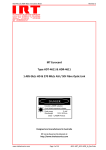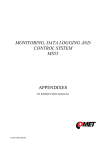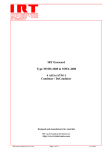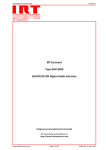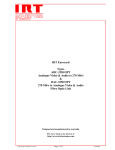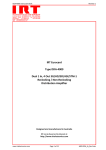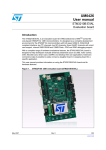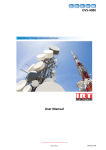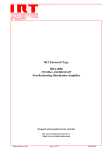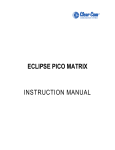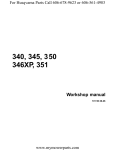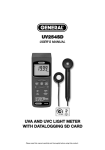Download User Manual - IRT Communications
Transcript
I R T Electronics Pty Ltd A.B.N. 35 000 832 575 26 Hotham Parade, ARTARMON N.S.W. 2064 AUSTRALIA National: Phone: (02) 9439 3744 Fax: (02) 9439 7439 International: +61 2 9439 3744 +61 2 9439 7439 Email: [email protected] Web: www.irtelectronics.com IRT Eurocard Type AMS-4370 4 Port Changeover Relay switcher for High Definition Digital Video, SDI, ASI, G.703, or Analogue Video Designed and manufactured in Australia IRT can be found on the Internet at: http://www.irtelectronics.com 4370-ams.ib.rev3.doc Page 1 of 14 31/05/2008 IRT Eurocard AMS-4370 – 4 Port Changeover Relay switcher for High Definition Digital Video, SDI, ASI, G.703 or Analogue Video Instruction Book Table of Contents Section Page Operational Safety General Description Technical Specifications Pre-Installation Internal Adjustments Configuration Installation & Operation SMU-4000 Installation Figure 1: SMU-4000 module AMS-4370 SNMP Functions Front & rear panel connector diagrams SNMP – What Is It? Maintenance & Storage Warranty & Service Equipment return Drawing Index 2 3 4 5 6 6 7 8 8 9 10 11 13 13 13 14 This instruction manual applies to units later than S/N 0711001. Operational Safety: WARNING Operation of electronic equipment involves the use of voltages and currents that may be dangerous to human life. Note that under certain conditions dangerous potentials may exist in some circuits when power controls are in the OFF position. Maintenance personnel should observe all safety regulations. Do not make any adjustments inside equipment with power ON unless proper precautions are observed. All internal adjustments should only be made by suitably qualified personnel. All operational adjustments are available externally without the need for removing covers or use of extender cards. 4370-ams.ib.rev3.doc Page 2 of 14 31/05/2008 General Description The AMS-4370 is a magnetic latching 4 port changeover switcher using enhanced performance relays which provide switching capabilities for high speed data signals up to 1.485 Gb/s. It is suitable for switching high definition video (HDSDI*), ASI, SDI, G.703 data streams, or analogue video signals. The AMS-4370 is arranged as a changeover switch with two inputs and two outputs. No terminations are provided on the board allowing the switcher to be used in a wide variety of applications and with signals of various types and impedances. The magnetic latching characteristic of the high performance relays allows momentary control and also provides for no change of path during power loss. Remote changeover is by a momentary ground connection. The AMS-4370 is ideally suited to applications where a simple choice between two inputs or outputs is required and may be easily driven by detector circuits for automatic path selection. Remote indication of tally and local/remote status is provided for integration into central alarm and monitoring systems. The AMS-4370 relay card is built to the Eurocard format and is designed to fit IRT’s Standard Eurocard frame as well as IRT’s 4000 series frame for use with IRT’s SNMP system and may be used alongside any other of IRT’s analogue or digital Eurocards. Standard features: • • • • • • Signal path suitable for HDSDI (1.485Gb/s), SDI , analogue video, ASI data streams and G703 signals @ 2, 8, 34, 45, 144, 155Mb/s. Momentary Set/Reset control. No path change on power fail. Local or remote control. Front panel LED status indicators. Optional plug in SNMP monitoring and switching module. AMS-4370 Block diagram IN B OUT A IN A OUT B Mode Status SNMP Set Reset NOTE: * For HDSDI applications, it is recommended that the AMS-4370 be used in either IRT’s 1RU or 4000 series 3RU frames only. 4370-ams.ib.rev3.doc Page 3 of 14 31/05/2008 Technical Specifications IRT Eurocard module Type AMS-4370 Signal path: Signal types Switching characteristic Crosstalk between channels HDSDI/SDI/ASI/G703/Video Magnetic latching 4 port changeover relay. < -50 dB to 300 MHz, < -30 dB to 1.5 GHz. Frequency response +0/-0.5 dB 0 Hz to 750 MHz, +0/-1.5 dB 750 MHz to 1.5 GHz. Auxilliary Data: Mode TTL level: Local = 0V (LOW); Remote = 4.5V (HIGH) via pull-up resistor, or open drain (link selectable). Magnetic latching relay changeover contact set. Common can be left open, or linked to ground or +12V of the main board. Data/Tally Remote Control: Mode Momentary ground, or TTL compatible circuit with 2k7 internal pull-up resistors to +4.5V. Power requirement 1.5 mA sink to ground. Connectors: Video: Video Tally Video Control BNC. 3 pin Phoenix pluggable screw block. 4 pin Phoenix pluggable screw block. Other: Relay contact rating 24 Vdc - 1 A 100 Vac - 0.3 A Power requirements: Power consumption Temperature range 28 Vac CT (14-0-14) or ± 16 Vdc 1 VA. 0 - 50° C ambient Mechanical Suitable for mounting in IRT 19" rack chassis with input, output and power connections on the rear panel. Grey background, silk-screened black lettering & red IRT logo. Detachable silk-screened PCB with direct mount connectors to Eurocard and external signals. 6 HP x 3 U x 220 mm IRT Eurocard. Finish: Front panel Rear assembly Dimensions Supplied accessories Optional accessories Rear connector assembly with matching connectors for control input and tally/mode outputs. Instruction manual. SMU-4000 SNMP plug-in module for use with 4000 series frame fitted with SNMP “Agent”. Due to our policy of continuing development, these specifications are subject to change without notice. 4370-ams.ib.rev3.doc Page 4 of 14 31/05/2008 Pre-Installation Pre-installation: Handling: This equipment may contain or be connected to static sensitive devices and proper static free handling precautions should be observed. Where individual circuit cards are stored, they should be placed in antistatic bags. Proper antistatic procedures should be followed when inserting or removing cards from these bags. Power: AC mains supply: Ensure that operating voltage of unit and local supply voltage match and that correct rating fuse is installed for local supply. DC supply: Ensure that the correct polarity is observed and that DC supply voltage is maintained within the operating range specified. Earthing: The earth path is dependent on the type of frame selected. In every case particular care should be taken to ensure that the frame is connected to earth for safety reasons. See frame manual for details. Signal earth: For safety reasons a connection is made between signal earth and chassis earth. No attempt should be made to break this connection. 4370-ams.ib.rev3.doc Page 5 of 14 31/05/2008 Internal Adjustments The AMS-4370 requires no internal adjustments for correct operation. Configuration Link Settings: LK1 LK2 LK3 IN OUT LK4 1-2 2-3 OUT LK5 IN OUT Not fitted / Not used. Hard wired pins 2-3 / Not configurable. External remote control acts in toggle (non magnetic latch) mode. External remote control acts in Set/Reset (magnetic latch) mode. Relay K3 Common (SK6-1 on rear assembly) set to +12Vdc via a 4R7 resistor. Relay K3 Common (SK6-1 on rear assembly) set to Ground. Relay K3 Common (SK6-1 on rear assembly) open (floating). Local/Remote tally 4.5V via pull-up resistor for Remote setting. Local/Remote tally open drain for Remote setting. Remote control mode: With the front panel Local/Remote switch set for remote control operation, control of the AMS-4370 changeover relay is by momentary ground contact only, via SK5 on the rear assembly. Local control mode: With the front panel Local/Remote switch set for local control operation, control of the AMS-4370 changeover relay is by front panel momentary Main/Standby switch. Remote switching via SK5 is still possible even with the front panel Local/Remote switch set to local. Input termination: No terminations are provided on the module so that the switcher can function in changeover mode. For 2 x 1 switcher applications the following terminations should be installed. Output A (Main) only is used and should be terminated at connected equipment. Output B (Standby) should be terminated in 75 Ohms (or 50 Ohms if being used for 50 Ohm RF signals) using a BNC termination plug. 4370-ams.ib.rev3.doc Page 6 of 14 31/05/2008 Installation & Operation Installation in frame or chassis: See details in separate manual for selected frame type. See also Configuration section. Signal connections: Signal connections are made to BNC coaxial connectors. No termination of inputs is provided on the module. When switched to the output the input load impedance is that of the load connected to the output. Where the input signal is required to be terminated, and one of the outputs is not connected to anything, then this unconnected output should be terminated by an appropriate BNC terminator of the required impedance. Control connections: Switch status is made by a relay contact on SK6 connector (Video Tally) located on the rear assembly. With pin 3 short circuited to pin 1 (pins 1 and 2 open circuited), module is in RESET position, i.e. Input A (Main) to Output A and Input B (Standby) to Output B. Likewise, if pin 2 is short circuited to pin 1 (pins 1 and 3 open circuited) then module is in SET position, i.e. Input A (Main) to Output B and Input B (Standby) to Output A. Video Tally input connector SK6 pin configuration is as follows: Pin Description 1 Relay common (contact connected to either +12Vdc via 4R7 resistor, ground, or open via link LK4 position – see Configuration section) 2 Relay SET contact – I/P B (Standby) selected 3 Relay RESET contact – I/P A (Main) selected Remote control connections are via SK5 connector located on the rear assembly. Control input connector SK5 pin configuration is as follows: Pin Description 1 SET control – select Input B (Standby) to Output A 2 RESET control – select Input A (Main) to Output A 3 Local/Remote tally indication 4 Ground Connecting the appropriate control input momentarily to ground will cause the relays to operate and the output state to cross over as follows: Control Input Output SET (Gnd) A (Main) ↔ B B (Standby) ↔ A RESET (Gnd) A (Main) ↔ B (Standby) ↔ A B With LK3 IN, the SET control (SK5-1) behaves as a toggle mode. Grounding this pin will set Input A (Main) to Output B, and Input B (Standby) to Output A. Removing this ground will automatically reset Input A (Main) to Output A, and Input B (Standby) to Output B. Toggle mode of operation will also work with TTL logic level controls. Local/Remote mode tally is made by pin 3 of SK5. The tally uses TTL logic to indicate local or remote setting. The local setting is indicated by approximately 0V (LOW) on pin 3 of SK5, whilst the remote setting, with link LK5 IN, is indicated by approximately 4.5V (HIGH) via a pull-up resistor on the same pin, or with link LK5 OUT remote setting is indicated by an open drain output of a FET transistor. 4370-ams.ib.rev3.doc Page 7 of 14 31/05/2008 Front Panel controls: On the front panel there are two switches. The upper switch is a centre position momentary 2 way switch for selecting between the inputs A (Main) and B (Standby). In order for this switch to operate the lower switch, which is a 2 way toggle switch, must be set to the Local position. With the lower switch set to the Remote position, the upper Input Select switch does not operate. With the Local/Remote switch set to the Local position, a red LED illuminates to give a visual warning indication that the unit is in local operation. The AMS-4370 is intended to be controlled by momentary contact closures only. If a remote control was to be a permanent ground, as opposed to a momentary ground, then this control will hold control of the switcher. Even if the switcher was to be set to the local position, local control will not operate whilst this remote control has control. With the switcher set to the Local control position, it is still possible for a remote control to operate and over-ride the local control setting. Front panel LEDs give a visual indication of inputs selected. VID MAIN (Input A) LED is a green LED and indicates that Input A (Main) is switched to Output A, and Input B (Standby) is switched to Output B. VID STANDBY (Input B) LED is a yellow LED and indicates that Input A (Main) is switched to Output B, and Input B (Standby) is switched to Output A. SMU-4000 Installation The SMU-4000 plug-in SNMP management controller module can only be fitted to IRT’s 4000 series modules that are capable of being SNMP upgradeable. To determine whether a module is SNMP upgradeable, a square section on the main PCB is silk screened and fitted with three multipin sockets – as shown below: 1J1 1J3 1J2 This is where the SMU-4000 plug-in SNMP management controller module is fitted. The three sets of multipins on the underside of the SMU-4000 line up with the three sets of multipin sockets on the main PCB module. Align all pins and then gently press the SMU-4000 all the way down into place. If the SMU-4000 is not already programmed with the correct firmware to match the module that it is being plugged into, it then needs to be programmed via the pins on the topside of the SMU-4000. Note that installation will generally be done by IRT Electronics at the time of ordering. Note also that an SMU-4000 will only be functionally operational when the main module that it is plugged into is fitted into an IRT 4000 series frame fitted with a CDM-4000 SNMP agent and being interrogated by a suitable Network Management System. Figure 1: SMU-4000 module 4370-ams.ib.rev3.doc Page 8 of 14 31/05/2008 AMS-4370 SNMP Functions: With the AMS-4370 fitted with the optional plug-in SMU-4000 SNMP module, programmed with the firmware to suit and installed in an IRT 4000 series frame with SNMP capability, the unit can be interrogated by an SNMP Network Management System (NMS). The following SNMP functions are capable of being monitored by an NMS: An indication of the state of the magnetic latching relays. InAoutA defines Input A connected to Output A and Input B connected to Output B. inAoutB defines Input A connected to Output B and Input B connected to Output A; An indication of the state of the front panel Remote/Local Switch. SNMP control is disabled and front panel control is enabled if this switch is in the Local position. External control (ie via the rear assembly) is always in operation; An indication if any external controls (via the rear assembly), or the front panel Set/Reset switch are operated; Whether “Trap” function is enabled; Trap automatically sent, if enabled, when the module status changes; A number that increases by one for every trap sent; and Unit reset control. 4370-ams.ib.rev3.doc Page 9 of 14 31/05/2008 Front & rear panel connector diagrams The following front panel and rear assembly drawings are not to scale and are intended to show relative positions of connectors, indicators and controls only. 4 PORT CHANGE-OVER AM S -4 3 7 0 P4 IN B OUT A LOCAL SK1 IN A MAIN STANDBY SK2 VID OUT B SK3 MAIN SK4 STANDBY REMOTE LOCAL DC 1 2 3 SK6 VIDEO TALLY SK5 1 2 N140 4370-ams.ib.rev3.doc 3 4 CONTROL Page 10 of 14 P3 31/05/2008 SNMP What Is It? SNMP stands for Simple Network Management Protocol. It is an application layer protocol for managing IP (Internet Protocol) based systems. SNMP enables system administrators to manage system performance, and to find and solve system problems. SNMP runs over UDP (User Datagram Protocol), which in turn runs over IP. Three types of SNMP exist: SNMP version 1 (SNMPv1), SNMP version 2 (SNMPv2) and SNMP version 3 (SNMPv3). It is not the intention here to discuss the differences between various versions, only to bring attention to the fact that IRT Electronics modules, fitted with SNMP capability, use SNMPv1. An SNMP managed network consists of three key components: Network Management Systems (NMS), agents, and managed devices. An NMS is the console through which the network administrator performs network management functions, such as monitoring status (e.g. alarm states) and remote controlling, of a set of managed devices. One or more NMSs must exist on any managed network. Generally the NMS is a computer running third party SNMP control software. There are a number of third party SNMP software applications currently available on the market. An NMS polls, or communicates with, an agent. An agent is a network management software module that resides in a managed device. An agent has local knowledge of management information and translates that information into a form compatible with SNMP. The agent, therefore, acts as an interface between the NMS and the managed devices. The NMS sends a request message, and control commands for the managed devices, to the agent, which in turn sends a response message, containing information about the managed devices, back to the NMS. A managed device contains an SNMP agent and resides on a managed network. Managed devices collect and store management information and make this information available to NMSs using SNMP. Managed device agent variables are organised in a tree structure known as a Management Information Base (MIB). Within the MIB are parameters pertaining to the managed device. An Object Identifier (OID) number within the MIB defines the managed device type. This is a unique number specific to the model of managed device. Other information relating to the device is also stored, information such as alarm states, controllable settings, etc. The MIB tree is organised in such a way that there will be no two MIB files with conflicting placements. Normally an NMS polls an agent for information relating to the MIB in a managed device to be sent back to the NMS. When certain conditions are met within the MIB, such as major alarm conditions, for example, the agent automatically sends what is known as a trap to the NMS without any prompting from the NMS. This allows automatic notification of a predetermined event. SNMP Block Diagram NMS IP Network NMS 4370-ams.ib.rev3.doc Page 11 of 14 SNMP Agent Protocol Engine MIB SNMP Agent SNMP Agent Protocol Engine MIB SNMP Agent SNMP Agent Protocol Engine MIB SNMP Agent 31/05/2008 SNMP with IRT Products: IRT Electronics currently employs SNMPv1 with its 4000 series frame. The frame acts as an agent when fitted with a CDM-4000 module. This module has its own designated slot next to the power supply so as to not affect the number of modules that the frame will take. Communication between the NMS, the frame and its loaded modules are via this CDM-4000 module. Note that the NMS software is third party and not supplied by IRT Electronics. Ethernet connection for SNMP operation is via an RJ45 connector on the rear of the frame, below the mains inlet. Ethernet rate runs at either 10 baseT or 100 baseT. Frame parameters, such as Name, Address and Location, are set via an RS232 interface, a D9 connector on the rear of the frame below the mains inlet. A software terminal emulator, such as Tera Term or HyperTerminal, is used for setting and reading the parameters of the frame. IRT modules that are SNMP compatible need a plug-in SMU-4000 module with a program relevant to the module that it is plugged into. Depending on the module, besides the module identification, parameters such as alarm states, inputs and controls etc. are communicated to the CDM-4000 agent via a data bus on the rear of the frame. Thus the CDM-4000 collects information on what is loaded within the frame, what positions they occupy, and their current status for communication to the NMS when the NMS sends a request for information. In the event of a major alarm from any of the SNMP compatible modules, or power supplies, a trap is automatically sent by the CDM-4000 agent to the NMS without any prompting by the NMS. This alerts the operator to any fault conditions that may exist that need immediate attention. 110/240 V 50/60 Hz 0.7 A (max.) FRU-4000 FRAME FUSES 220/240 Vac 500 mA S.B. 110/120 Vac 1A S.B. RS232 Alarm Ethernet + 48Vdc AS3260 approval no.: CS6346N Ass. no.: 804692 IRT SNMP Connections IRT modules fitted with SMU-4000 NMS Ethernet Cable IP Network CDM-4000 PSU’s IRT 4000 Series Frame Ethernet Cable IRT modules fitted with SMU-4000 CDM-4000 PSU’s IRT 4000 Series Frame Ethernet Cable IRT 4000 Series SNMP Setup 4370-ams.ib.rev3.doc Page 12 of 14 31/05/2008 Maintenance & storage Maintenance: No regular maintenance is required. Care however should be taken to ensure that all connectors are kept clean and free from contamination of any kind. This is especially important in fibre optic equipment where cleanliness of optical connections is critical to performance. Storage: If the equipment is not to be used for an extended period, it is recommended the whole unit be placed in a sealed plastic bag to prevent dust contamination. In areas of high humidity a suitably sized bag of silica gel should be included to deter corrosion. Where individual circuit cards are stored, they should be placed in antistatic bags. Proper antistatic procedures should be followed when inserting or removing cards from these bags. Warranty & Service Equipment is covered by a limited warranty period of three years from date of first delivery unless contrary conditions apply under a particular contract of supply. For situations when “No Fault Found” for repairs, a minimum charge of 1 hour’s labour, at IRT’s current labour charge rate, will apply, whether the equipment is within the warranty period or not. Equipment warranty is limited to faults attributable to defects in original design or manufacture. Warranty on components shall be extended by IRT only to the extent obtainable from the component supplier. Equipment return: Before arranging service, ensure that the fault is in the unit to be serviced and not in associated equipment. If possible, confirm this by substitution. Before returning equipment contact should be made with IRT or your local agent to determine whether the equipment can be serviced in the field or should be returned for repair. The equipment should be properly packed for return observing antistatic procedures. The following information should accompany the unit to be returned: 1. 2. 3. 4. 5. 6. 7. A fault report should be included indicating the nature of the fault The operating conditions under which the fault initially occurred. Any additional information, which may be of assistance in fault location and remedy. A contact name and telephone and fax numbers. Details of payment method for items not covered by warranty. Full return address. For situations when “No Fault Found” for repairs, a minimum charge of 1 hour’s labour will apply, whether the equipment is within the warranty period or not. Contact IRT for current hourly rate. Please note that all freight charges are the responsibility of the customer. The equipment should be returned to the agent who originally supplied the equipment or, where this is not possible, to IRT direct as follows. Equipment Service IRT Electronics Pty Ltd 26 Hotham Parade ARTARMON N.S.W. 2064 AUSTRALIA Phone: Email: 4370-ams.ib.rev3.doc 61 2 9439 3744 [email protected] Page 13 of 14 Fax: 61 2 9439 7439 31/05/2008 Drawing Index Drawing # Sheet # Description 805248 805248 805248 805248 1 2 3 4 AMS-4370 main circuit schematic. AMS-4370 Rear Connector Panel. AMS-4370 Power Supply. AMS-4370 SNMP interface. 4370-ams.ib.rev3.doc Page 14 of 14 31/05/2008 STANDBY MAIN Local LD6 green PCB 805249 R20 560R LD1 green (MAIN) 3 1 6 4 6 K3B LD2 yellow (STANDBY) R21 560R VIDEO TALLY +5V BAS16 2 D8 4 Remote 3 1 R29 560R +5V SW1A SW1B 'DC' 2 5 5 SW2B 2 2 1 2 1 2 SW2A 1 3 R18 4K7 +5V R26 4K7 +5V D7 2 1 R30 2K2 R25 1 4K7 Q11 BSS123 2 2 nLOCAL +5V 3 D9 BAS16 BAS16 R17 4K7 1 3 (LOCAL) 1 2 2 1 1 2 2 1 1 1 2 1 LK5 R9 NU 1 1 Q7 NU LK2 LK1 NU 1 1 2 2 2 D3 NU 1 NU C3 NU R11 1 1K C2 100nF R7 R8 2K2 1 +5V +5V +5V R22 NU LD3 NU 1 R13 270R 10uF +5V 1 Q3 BSS123 2 C4 +5V 2 1 1 1 Q10 BSS123 R14 4K7 +5V +5V LK3 Q9 NU 1 Q6 BSS123 2 R15 4K7 3 4 U2 +12V G3VM-351G 1 D4 NU LD4 NU Video Cross-talk <-50dB @ 270 MHz Video Cross-talk <-30dB @ 1.5GHz 2 1 10uF SET C5 R K3A G5AK-234P S 2 2 D5 BAS16 6 7 1 +12V 2 2 1 2 NU R23 1 +12V +12V 805248s2n.sch Rear Connector Panel 805248s3.sch Power Supply AC-1 AC-2 AC-3 AC-4 AC-1 AC-2 AC-3 AC-4 LK4 SETS DC OF VIDEO TALLY RELAY COMMON NU R24 2 G6ZK-1PE R S C K2 CLOSE LK3 TO DISABLE MAGNETIC LATCHING FOR SINGLE LINE VIDEO CONTROL USING THE STANDBY (VIDEO B) CONTROL LINE D6 2 BAS16 1 3 RESET 4 U1 +12V G3VM-351G R16 270R +5V CLOSE LK5 IF PULL-UP VOLTAGE REQUIRED FOR LOCAL TALLY. 1 Q8 NU R12 NU 1 Q5 BSS123 AUDIO CONTROL 2 R10 NU +5V 2 1 R4 2K2 Q2 BSS123 TX RX 1K C1 100nF R3 D2 BAS16 R6 2K2 +5V 2 R2 2K2 +5V D1 BAS16 RESET (VIDEO A) SET (VIDEO B) VIDEO TALLY AUDIO TALLY LOC.ACTIVE REM/LOC 805248s4.sch Q12 BSS123 3 3 RESET CONTROL R5 4K7 1 Q4 BSS123 SET CONTROL R1 4K7 1 Q1 BSS123 nVIDEO A nAUDIO A nLOCAL SNMP Interface 1 LD5 'red' 5 1 2 R19 560R 6 2 1 1 2 2 1 1 3 2 1 2 1 2 1 3 1 +5V 2 2 1 2 1 2 1 12 1 3 2 3 2 3 2 11 2 3 1 2 1 3 1 2 1 3 1 2 2 1 2 1 2 1 2 1 3 2 2 1 3 3 2 1 2 3 2 1 2 3 2 1 2 2 1 3 2 3 2 2 1 1 3 2 3 1 +5V 3 2 3 2 2 2 1 LK4 4R7 F5 14 13 12 11 10 9 8 1 3 +5V 2 8 9 10 11 12 13 14 1 07-06-2007 K3C C S R 7 8 1 7 6 OUT A OUT B IN A SET RESET AC-4 AC-3 AC-2 AC-1 TX RX 1 Date: 17-Oct-2007 Revision: ENG. APP. DRAWN K.N. CHECKED DO NOT COPY NOR DISCLOSE TO ANY THIRD PARTY WITHOUT WRITTEN CONSENT COPYRIGHT 805248 Sheet 1 of 4 AMS-4370 4 PORT CHANGE-OVER RELAY MODULE DIN64 Drawing No. Title 1A 1B 2A 2B 3A 3B 4A 4B 5A 5B 6A 6B 7A 7B 8A 8B 9A 9B 10A 10B 11A 11B 12A 12B 13A 13B 14A 14B 15A 15B 16A 16B 17A 17B 18A 18B 19A 19B 20A 20B 21A 21B 22A 22B 23A 23B 24A 24B 25A 25B 26A 26B 27A 27B 28A 28B 29A 29B 30A 30B 31A 31B 32A 32B IRT Electronics Pty. Ltd. ARTARMON NSW AUSTRALIA 2064 SCALE N.T.S. A3 SIZE Relays shown in RESET or OFF position. 10 G6ZK-1PE K1 IN B P1 1 07-06-2007 COPYRIGHT 1A 1B 2A 2B 3A 3B 4A 4B 5A 5B 6A 6B 7A 7B 8A 8B 9A 9B 10A 10B 11A 11B 12A 12B 13A 13B 14A 14B 15A 15B 16A 16B 17A 17B 18A 18B 19A 19B 20A 20B 21A 21B 22A 22B 23A 23B 24A 24B 25A 25B 26A 26B 27A 27B 28A 28B 29A 29B 30A 30B 31A 31B 32A 32B 1 Date: 17-Oct-2007 Revision: ENG. APP. DRAWN K.N. CHECKED DO NOT COPY NOR DISCLOSE TO ANY THIRD PARTY WITHOUT WRITTEN CONSENT DIN64 J1 L3R 2 1 1 3.3nH L4R 3.3nH P3 J3 L2R 3.3nH 1 1 RX 1 1 1 1 SK2 SK3 SK4 CONTROL VIDEO TALLY AMS-4370 SK5 SK6 OUT B IN A OUT A IN B 805248 Sheet 2 of 4 Rear Connector Panel Drawing No. Title 1 2 3 4 SK1 IRT Electronics Pty. Ltd. ARTARMON NSW AUSTRALIA 2064 SCALE N.T.S. A3 SIZE GND = VIDEO B (STANDBY) GND = VIDEO A (MAIN) LOCAL TALLY (0.1 Volts) REMOTE TALLY (4.7Volts) OR OPEN DRAIN Common contact 1 Contact CLOSED STANDBY (B) 2 3 Contact CLOSED MAIN (A) 1 3 5 7 9 1 2 3 2 2 L1R 6 5 3.3nH 4 2 2 3 P4 TX 1 2 2 2 2 C18 100uF C17 1uF 1 2 3 4 8 7 6 5 LM78L05ACM O I G G G G n.c. n.c. 1 2 1 2 1 2 C16 1uF +12V +12V C15 100uF C14 1uF 1 O O 2 255R R27 2K2 R28 2 4 Adj 1 2 1 2 U4 I 3 1 2 +5V C13 1uF 1 2 U3 LM317S C12 470uF 1 2 C11 470uF 1 1 1 S1B D14 S1B D13 S1B D12 S1B D11 2 2 2 2 2 2 2 2 F1 4R7 F4 4R7 F3 4R7 F2 4R7 1 1 1 1 3 3 FL1 FL3 2 2 1 2 1 3 3 1 1 FL2 FL4 2 2 1 1 1 1 07-06-2007 K.N. Date: 17-Oct-2007 Revision: 1 ENG. APP. CHECKED DRAWN DO NOT COPY NOR DISCLOSE TO ANY THIRD PARTY WITHOUT WRITTEN CONSENT COPYRIGHT AC-4 AC-3 AC-2 AC-1 AMS-4370 Power Supply Drawing No. 805248 Title Sheet 3 of 4 IRT Electronics Pty. Ltd. ARTARMON NSW AUSTRALIA 2064 SCALE N.T.S. A3 SIZE ASSEMBLY 804857 SNMP CPU Sub-Module SMU-4000 1J1 1J2 1J3 PTA2 PTA4 PTA5 PTA6 PTA7 5 4 3 2 1 C6 1 13B 13A nINPUT "A" SELECTED nINPUT "A" SELECTED PTB7 PTB4 PTB5 PTB2 PTB3 PTB0 PTB1 6 5 4 3 2 1 nLOCAL CONTROL SELECTED PTB6 nLOCAL CONTROL ACTIVE SELECT INPUT B SELECT INPUT A SELECT AUDIO B 7 100nF 2 8 9 10 PTA3 PTA0 6 PTA1 7 PAD4 +5V 8 9 10 1 2 3 4 5 6 RX TX K.N. Date: 17-Oct-2007 Revision: 1 ENG. APP. CHECKED DRAWN DO NOT COPY NOR DISCLOSE TO ANY THIRD PARTY WITHOUT WRITTEN CONSENT COPYRIGHT VIDEO TALLY AUDIO TALLY REM/LOC LOC.ACTIVE SET (VIDEO B) RESET (VIDEO A) SELECT AUDIO B 1 07-06-2007 AMS-4370 SNMP interface Drawing No. 805248 Title Sheet 4 of 4 IRT Electronics Pty. Ltd. ARTARMON NSW AUSTRALIA 2064 SCALE N.T.S. A3 SIZE



















